Dell Venue 11 Pro: a powerful tablet with room for growth
In late January, the Dell Venue 11 Pro tablet went on sale in the States. After waiting for a spectacular pause, he reached the Russian stalls. Taking a closer look at the older model, I came to the conclusion that, due to the inexorable increase in the performance of mobile Intel processors, the line between devices is erased. And what is called a tablet can actually replace not only a mobile, but also a desktop computer. Unless, of course, be prepared to support progress financially.

But before I talk about the new device, I think it is right to recall the Dell Latitude 10 tablet, bought a year and a half ago. Because it was from him and his fellows on the new (at that time) Intel Atom processor that hybrid computers from beautiful concepts became part of everyday life.
')
About Latitude 10, I once wrote a great post. If interested - I recommend to study . Let me remind you that this is a 10-inch tablet computer on the Intel Atom Z2760, running Windows 8.
As suggested in the post about him, the tablet was useful for short-term business trips, when you take with you only a backpack with a minimum of things. The cover that came with the tablet not only protected it from contact with solid objects in the backpack, but also allowed to put the Latitude 10 at any desired angle. You can watch a movie, write anything on Facebook, and if you want to work, you plug in a compact Logitech Bluetooth keyboard Illuminated Keyboard K810. In the summer in Kazan, I even had to process a dozen RAW photos on the tablet, the benefit of which was installed for Photoshop tests in the system. Well, what can I say ... If you squeeze, you can work on the "Atom" with 2 gigabytes of RAM. But only if he presses. Probably, if there were not ten photographs, but thirty, I would have baked. If you only download one at a time and convert to JPEG without any modification at all.
After six months of operation with the tablet, something bad happened: the battery stopped charging. In a friendly workshop, I was told that such is now in laptops quite often and is treated by opening the battery case and then charging the “cans” separately. Say, if for some reason they are discharged unevenly, the controller goes crazy and decides that everything is gone. We did this operation, but after a month the battery failed again. I already decided to order a new one on eBay, but then I remembered the Dell international warranty. Filled out the form on the site, indicated the serial number. And what do you think? On the same day, a girl who spoke in Russian with some exotic accent called, listened to a description of the problem and offered to send a new battery. Ten days later he was delivered. Judging by the attached documents from the UK. I don’t know if this service extends only to business models, or to Dell with all of them. But I liked it.
After the release of the Windows 8.1 update, I installed it on Latitude 10 without any adventures (on the ultrabook, this farewell bow of Steve Ballmer slammed the sound and Wi-Fi drivers). The tablet still remains a pleasant machine, however, for serious tasks, unfortunately, it is not adapted. Even with a docking station with lots of different ports, I did not dare to use it as a working computer in the editorial office. Weak-s. Compared with the ultrabook - not at all.

And here came the new Dell Venue 11 Pro. I looked at the specifications and shook my head. Yeah, tablet, of course.
The dual-core Intel Core i5-4300Y processor from the Haswell family operates at a nominal frequency of 1.6 GHz, and under load it is able to overclock one of the cores to 2.3 GHz. The GT2 graphics core contains 20 execution units and, under load, is also trained to accelerate from the base 200 MHz to 800 MHz. This is not Intel Iris Graphics with 40 executive units, but still pretty strong. The processor is manufactured using 22-nanometer technology and fits into a TDP of 11.5 watts.
The onboard SSD is 128 GB. The good news is that it is not soldered on the board, and can be replaced with a more spacious one if necessary. The performance of the installed model (SanDisk SD6SP1M-128g-1012) pleased: read up to 489 MB / s, write up to 285 MB / s.
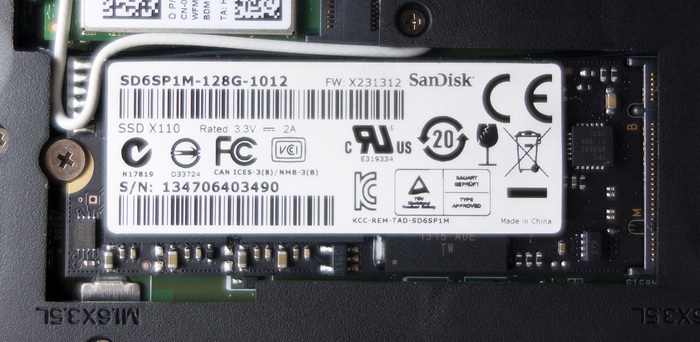
The volume of the pre-installed RAM in my instance is 4 GB and it will not work to upgrade it with my own hands - it is soldered on the motherboard. On the Dell website, you can order a model with 8 GB, but it comes with a 256 GB SSD and is more expensive (we’ll talk about pricing at the end).
Screen size is 10.8 inches. A good IPS matrix with a resolution of 1920x1080 pixels was used. The menu of old-school applications, to which, unfortunately, is Photoshop, on this screen look small. But if you are used to reading mail not through The Bat, but in Outlook, or even in the web interface, you shouldn’t have any difficulties with everyday work. Well, of course, except for the significant inconvenience when trying to control the tablet with your fingers in desktop applications.
The cameras in the tablet are two pieces, and the back is already 8-megapixel. By all indications, they are exactly the same as in Latitude 10, namely, suitable only for video conferencing. Photos, unfortunately, are very mediocre. However, show me a tablet where the cameras are really suitable for taking pictures.

On the sides of the Venue 11 Pro, there is a mini-HDMI port, a full-sized USB 3.0 connector and a microSD card slot.


The latter looks very funny: in the iPad, a SIM card is inserted into a similar tray. It is also in my copy, but to install it, you must remove the back cover and the battery. Long thought and wondered - why did they do that? I came to the conclusion that the LTE module is not installed in all configurations, and leaving the SIM card in a visible place is fraught with puzzled calls to tech support. And so like ours and yours.
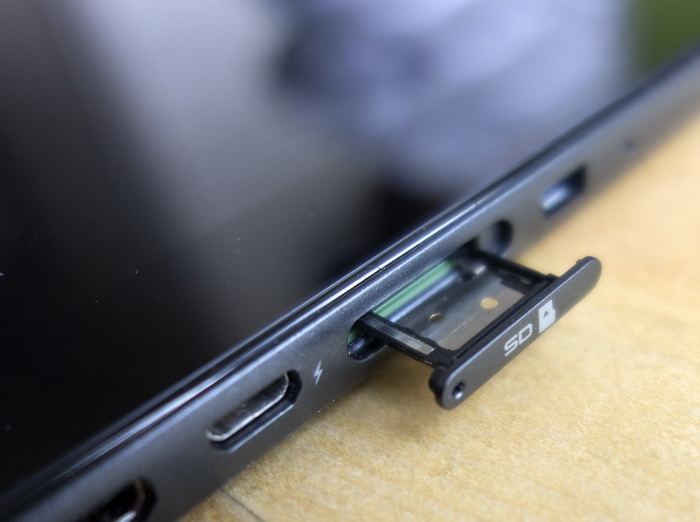
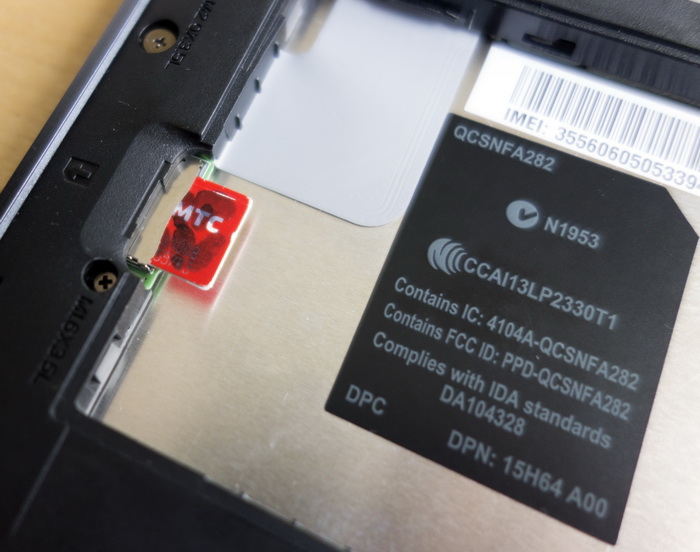
By the way, this module can also be added independently by purchasing from Dell or in alternative stores. It is written in capital letters QUALCOMM 4G, but when studying the characteristics of the model (EM8805), it is found that it only supports 3G with data download speeds of up to 42 Mbit / s (sending up to 5.76 Mbit / s). True, we do not have such wonders in the air and are unlikely to start, but if you suddenly find yourself in a deserted place of a large European city, you can enjoy it.

From a standard 36-watt-hour battery in the “office” mode, the tablet works for about seven hours. As, in general, and the majority of really compact ultrabooks on Haswell. If you’ve posted a lot to Facebook via the web interface, or set up a million of syncs with a large amount of data, the battery life will be reduced to six hours.
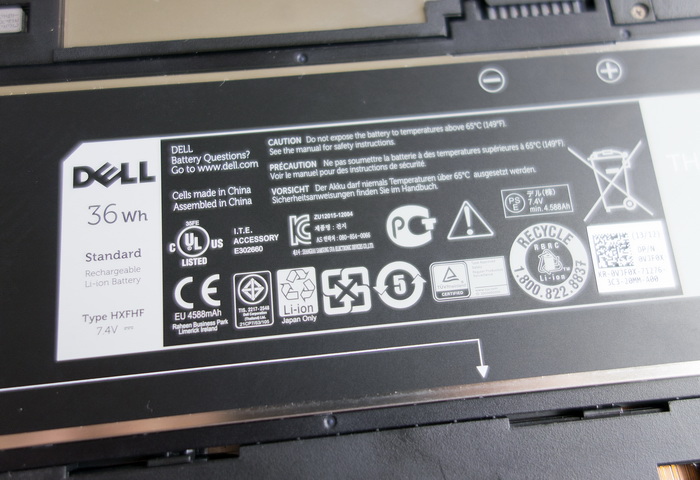
Dell Venue 11 Pro does not charge through its own non-standard interface, like my Latitude 10, but through the usual micro USB. So there will be no problems with finding a charger, just to give a current of at least 1A.
If we talk about overall performance, then in everyday tasks everything is very, very fast. There is nothing to complain about. Ultrabook on Haswell - he is the ultrabook on Haswell. For a full test of the suitability of the tablet for use in real life, I rolled on it World of Tanks. At the minimum settings, I received a guaranteed 30 frames per second on any maps, which in more or less closed spaces turn into 40-45. Play more than you can. By the way, it was in World of Tanks that I found that there was a fan in the tablet. In normal modes, he does not give voices, but then he began to make noise. However, nothing terrible, the sounds of the game, he does not drown out, but when you exit to the desktop almost immediately stops.
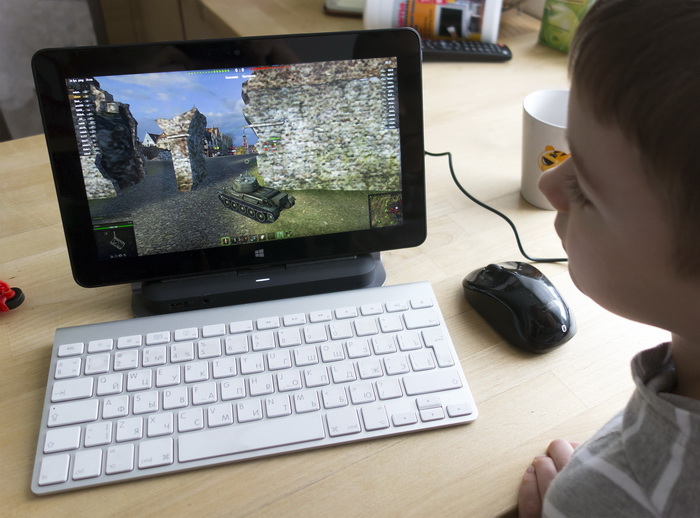
Dell is well aware that the tablet on Windows 8 in its “bare” form is not a completely finished device. Therefore, it is recommended to buy two types of keyboards. The first, the Dell Tablet Keyboard - Mobile, actually turns the tablet into an ultrabook. In addition to the keyboard and touchpad itself, a battery is built into the case, doubling the capacity of the on-board battery. If you want grace, you can choose the Dell Tablet Keyboard - Slim. There is no battery there, but it almost does not "fill" the tablet and allows you to install it on a flat surface at different angles. The price of the issue in the US online store Dell is $ 160 and $ 130, respectively (excluding sales tax).
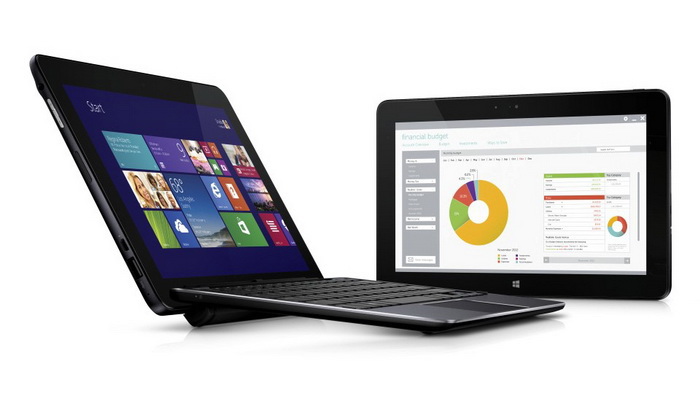
At the base of the tablet there is a connector for the docking station. Remembering the love of manufacturers to reinvent the connector once a year, without much optimism, I tried to connect the Venue 11 Pro to the dock from the Latitude 10, and take it and come! And life has improved dramatically, because it has a USB hub with 4 ports, an Ethernet jack, full-size HDMI and even a headphone output. Given the power tablet, nothing prevents to use it as a system unit, connecting the monitor and keyboard to taste. And another terabyte external hard drive for two. No seriously! No matter how good the screen is in a laptop, the diagonal of wearable models is always too small. And the keyboard of that ... with compromises. By connecting a monitor, keyboard and other necessary devices to the docking station, we get complete uncompromising comfort and sufficient (if not to say redundant) performance. And while the system unit can carry with them in the folder for papers. Conveniently? It seems to me - very. For the docking station (new, but not as rare as mine) I have to pay $ 130.

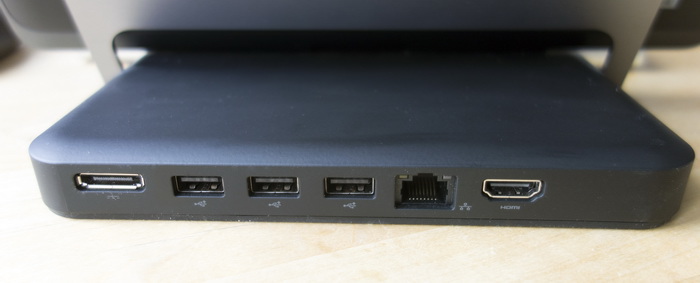
Some will say: yes, what is comfort in a bathhouse, if Windows 8 is there? I answer: when you use Venue 11 Pro, everything is very well tolerated. There are a lot of applications written for Modern UI, and even games are enough if you have time for them. And for normal work in the desktop mode, I always put a paid (but inexpensive) Start8 utility that returns a full-fledged Start button (for honest and economical, there is a free option not worse - Classic Shell). A couple of minutes, and the Modern UI will only appear when you yourself want it. But on the whole, the G8 is rather frisky and has not caused any irritation in a long time.
Now let's count. On www.dselect.ru it is written that Venue 11 Pro costs from 28,500 rubles. Indeed, for this amount you can buy a tablet, but inside it will be not the Core i5, but the Atom Z3770. Also a good processor, no doubt. Four cores, 2 MB cache in the second level, can accelerate under load right up to 2.4 GHz. However, the graphics core is weak there, and the amount of RAM and SSD is 2 and 64 GB, respectively (I’m stressing, this is not a processor limitation, but a Dell solution. Engineers say that Atom performance with 2 and 4 GB of RAM is a little different). Therefore, such a tablet will not work as a serious car.

The seriousness begins with the version on Core i3 with 4 GB of RAM and 128 GB SSD. It costs from 45 000 rubles, and for 48 400 you can already take a model with Core i5. The most sophisticated configuration (Core i5, 8 GB of RAM and 256 SSD) will cost approximately 55,000 rubles. It’s a pity, of course, that you can’t take a model with 8 GB of memory, and use microSD for data storage, which recently just reached 128 GB.
If we proceed from the price for the best for the average user version of c Core i5 for 48,000, then it must be added five thousand more for the snap-on keyboard. Which one is up to you. And now a full-fledged mobile computer. I want to “land it” and from time to time turn it into a system unit - we take a docking station, to it a monitor with an IPS-matrix and a keyboard / mouse. If you are not greedy, you will have to spend another sixteen or eighteen thousand (you do not want to work behind a cheap monitor, right?).
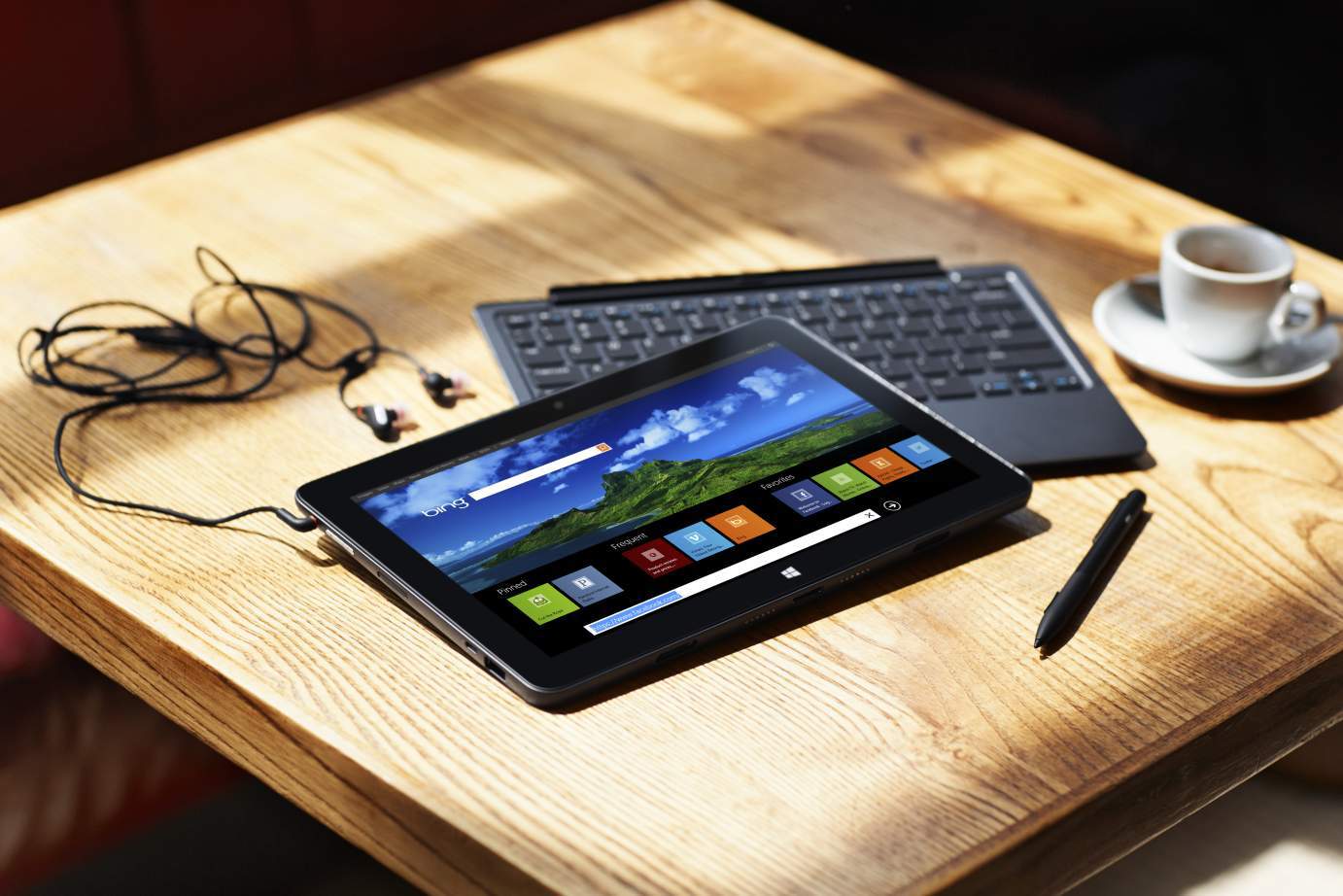
It turns out that the circle, to the maximum, is 65,000 rubles. Terribly expensive, right? But let's forget about saving for a moment and think about comfort. A good ultrabook with similar characteristics will cost about 46-47 thousand (if you look at models with processors from the Haswell family). And for this amount we get only a mobile computer, no matter how good it is. With a small screen, with a compact keyboard. I have a lot of acquaintances who, when they come home, connect a working laptop to a desktop monitor and connect a USB hub with a keyboard, but it doesn’t look very elegant. Place on the table is wasted. In the case of Dell Venue 11 Pro for 65,000 rubles, you can actually get three devices - a tablet, an ultrabook and a full-fledged desktop computer. If the task of equipping a workplace is not worth it, then you can restrict yourself with a tablet and an ultrabook, which will cost 53,900 rubles. The premium for universality is present, but rather moderate.
And yet the amount is serious, anyway. Readers are sure to tell in the comments - how much interesting can be bought instead of a tablet. For example, take a laptop easier and assemble another system unit.
Thrift in me is completely on the side of alternative solutions. But you know how great it is when you insert a compact and not at all heavy (770 grams) tablet into the docking station, and you can fully work on a large monitor. Then he pulled out - and took everything with him, not expecting any cloud synchronization, sifting a teaspoon per hour. Which, however, can continue through the mobile network, if you do not cheat on the tariff with a decent packet of traffic. The computer is one - but so many faces. And optimal for different life situations.
It remains from this model of using the feeling of touching the future. Perhaps this is it.

But before I talk about the new device, I think it is right to recall the Dell Latitude 10 tablet, bought a year and a half ago. Because it was from him and his fellows on the new (at that time) Intel Atom processor that hybrid computers from beautiful concepts became part of everyday life.
')
About Latitude 10, I once wrote a great post. If interested - I recommend to study . Let me remind you that this is a 10-inch tablet computer on the Intel Atom Z2760, running Windows 8.
As suggested in the post about him, the tablet was useful for short-term business trips, when you take with you only a backpack with a minimum of things. The cover that came with the tablet not only protected it from contact with solid objects in the backpack, but also allowed to put the Latitude 10 at any desired angle. You can watch a movie, write anything on Facebook, and if you want to work, you plug in a compact Logitech Bluetooth keyboard Illuminated Keyboard K810. In the summer in Kazan, I even had to process a dozen RAW photos on the tablet, the benefit of which was installed for Photoshop tests in the system. Well, what can I say ... If you squeeze, you can work on the "Atom" with 2 gigabytes of RAM. But only if he presses. Probably, if there were not ten photographs, but thirty, I would have baked. If you only download one at a time and convert to JPEG without any modification at all.
After six months of operation with the tablet, something bad happened: the battery stopped charging. In a friendly workshop, I was told that such is now in laptops quite often and is treated by opening the battery case and then charging the “cans” separately. Say, if for some reason they are discharged unevenly, the controller goes crazy and decides that everything is gone. We did this operation, but after a month the battery failed again. I already decided to order a new one on eBay, but then I remembered the Dell international warranty. Filled out the form on the site, indicated the serial number. And what do you think? On the same day, a girl who spoke in Russian with some exotic accent called, listened to a description of the problem and offered to send a new battery. Ten days later he was delivered. Judging by the attached documents from the UK. I don’t know if this service extends only to business models, or to Dell with all of them. But I liked it.
After the release of the Windows 8.1 update, I installed it on Latitude 10 without any adventures (on the ultrabook, this farewell bow of Steve Ballmer slammed the sound and Wi-Fi drivers). The tablet still remains a pleasant machine, however, for serious tasks, unfortunately, it is not adapted. Even with a docking station with lots of different ports, I did not dare to use it as a working computer in the editorial office. Weak-s. Compared with the ultrabook - not at all.

And here came the new Dell Venue 11 Pro. I looked at the specifications and shook my head. Yeah, tablet, of course.
The dual-core Intel Core i5-4300Y processor from the Haswell family operates at a nominal frequency of 1.6 GHz, and under load it is able to overclock one of the cores to 2.3 GHz. The GT2 graphics core contains 20 execution units and, under load, is also trained to accelerate from the base 200 MHz to 800 MHz. This is not Intel Iris Graphics with 40 executive units, but still pretty strong. The processor is manufactured using 22-nanometer technology and fits into a TDP of 11.5 watts.
The onboard SSD is 128 GB. The good news is that it is not soldered on the board, and can be replaced with a more spacious one if necessary. The performance of the installed model (SanDisk SD6SP1M-128g-1012) pleased: read up to 489 MB / s, write up to 285 MB / s.

The volume of the pre-installed RAM in my instance is 4 GB and it will not work to upgrade it with my own hands - it is soldered on the motherboard. On the Dell website, you can order a model with 8 GB, but it comes with a 256 GB SSD and is more expensive (we’ll talk about pricing at the end).
Screen size is 10.8 inches. A good IPS matrix with a resolution of 1920x1080 pixels was used. The menu of old-school applications, to which, unfortunately, is Photoshop, on this screen look small. But if you are used to reading mail not through The Bat, but in Outlook, or even in the web interface, you shouldn’t have any difficulties with everyday work. Well, of course, except for the significant inconvenience when trying to control the tablet with your fingers in desktop applications.
The cameras in the tablet are two pieces, and the back is already 8-megapixel. By all indications, they are exactly the same as in Latitude 10, namely, suitable only for video conferencing. Photos, unfortunately, are very mediocre. However, show me a tablet where the cameras are really suitable for taking pictures.

On the sides of the Venue 11 Pro, there is a mini-HDMI port, a full-sized USB 3.0 connector and a microSD card slot.


The latter looks very funny: in the iPad, a SIM card is inserted into a similar tray. It is also in my copy, but to install it, you must remove the back cover and the battery. Long thought and wondered - why did they do that? I came to the conclusion that the LTE module is not installed in all configurations, and leaving the SIM card in a visible place is fraught with puzzled calls to tech support. And so like ours and yours.


By the way, this module can also be added independently by purchasing from Dell or in alternative stores. It is written in capital letters QUALCOMM 4G, but when studying the characteristics of the model (EM8805), it is found that it only supports 3G with data download speeds of up to 42 Mbit / s (sending up to 5.76 Mbit / s). True, we do not have such wonders in the air and are unlikely to start, but if you suddenly find yourself in a deserted place of a large European city, you can enjoy it.

From a standard 36-watt-hour battery in the “office” mode, the tablet works for about seven hours. As, in general, and the majority of really compact ultrabooks on Haswell. If you’ve posted a lot to Facebook via the web interface, or set up a million of syncs with a large amount of data, the battery life will be reduced to six hours.

Dell Venue 11 Pro does not charge through its own non-standard interface, like my Latitude 10, but through the usual micro USB. So there will be no problems with finding a charger, just to give a current of at least 1A.
If we talk about overall performance, then in everyday tasks everything is very, very fast. There is nothing to complain about. Ultrabook on Haswell - he is the ultrabook on Haswell. For a full test of the suitability of the tablet for use in real life, I rolled on it World of Tanks. At the minimum settings, I received a guaranteed 30 frames per second on any maps, which in more or less closed spaces turn into 40-45. Play more than you can. By the way, it was in World of Tanks that I found that there was a fan in the tablet. In normal modes, he does not give voices, but then he began to make noise. However, nothing terrible, the sounds of the game, he does not drown out, but when you exit to the desktop almost immediately stops.

Dell is well aware that the tablet on Windows 8 in its “bare” form is not a completely finished device. Therefore, it is recommended to buy two types of keyboards. The first, the Dell Tablet Keyboard - Mobile, actually turns the tablet into an ultrabook. In addition to the keyboard and touchpad itself, a battery is built into the case, doubling the capacity of the on-board battery. If you want grace, you can choose the Dell Tablet Keyboard - Slim. There is no battery there, but it almost does not "fill" the tablet and allows you to install it on a flat surface at different angles. The price of the issue in the US online store Dell is $ 160 and $ 130, respectively (excluding sales tax).

At the base of the tablet there is a connector for the docking station. Remembering the love of manufacturers to reinvent the connector once a year, without much optimism, I tried to connect the Venue 11 Pro to the dock from the Latitude 10, and take it and come! And life has improved dramatically, because it has a USB hub with 4 ports, an Ethernet jack, full-size HDMI and even a headphone output. Given the power tablet, nothing prevents to use it as a system unit, connecting the monitor and keyboard to taste. And another terabyte external hard drive for two. No seriously! No matter how good the screen is in a laptop, the diagonal of wearable models is always too small. And the keyboard of that ... with compromises. By connecting a monitor, keyboard and other necessary devices to the docking station, we get complete uncompromising comfort and sufficient (if not to say redundant) performance. And while the system unit can carry with them in the folder for papers. Conveniently? It seems to me - very. For the docking station (new, but not as rare as mine) I have to pay $ 130.


Some will say: yes, what is comfort in a bathhouse, if Windows 8 is there? I answer: when you use Venue 11 Pro, everything is very well tolerated. There are a lot of applications written for Modern UI, and even games are enough if you have time for them. And for normal work in the desktop mode, I always put a paid (but inexpensive) Start8 utility that returns a full-fledged Start button (for honest and economical, there is a free option not worse - Classic Shell). A couple of minutes, and the Modern UI will only appear when you yourself want it. But on the whole, the G8 is rather frisky and has not caused any irritation in a long time.
Now let's count. On www.dselect.ru it is written that Venue 11 Pro costs from 28,500 rubles. Indeed, for this amount you can buy a tablet, but inside it will be not the Core i5, but the Atom Z3770. Also a good processor, no doubt. Four cores, 2 MB cache in the second level, can accelerate under load right up to 2.4 GHz. However, the graphics core is weak there, and the amount of RAM and SSD is 2 and 64 GB, respectively (I’m stressing, this is not a processor limitation, but a Dell solution. Engineers say that Atom performance with 2 and 4 GB of RAM is a little different). Therefore, such a tablet will not work as a serious car.

The seriousness begins with the version on Core i3 with 4 GB of RAM and 128 GB SSD. It costs from 45 000 rubles, and for 48 400 you can already take a model with Core i5. The most sophisticated configuration (Core i5, 8 GB of RAM and 256 SSD) will cost approximately 55,000 rubles. It’s a pity, of course, that you can’t take a model with 8 GB of memory, and use microSD for data storage, which recently just reached 128 GB.
If we proceed from the price for the best for the average user version of c Core i5 for 48,000, then it must be added five thousand more for the snap-on keyboard. Which one is up to you. And now a full-fledged mobile computer. I want to “land it” and from time to time turn it into a system unit - we take a docking station, to it a monitor with an IPS-matrix and a keyboard / mouse. If you are not greedy, you will have to spend another sixteen or eighteen thousand (you do not want to work behind a cheap monitor, right?).

It turns out that the circle, to the maximum, is 65,000 rubles. Terribly expensive, right? But let's forget about saving for a moment and think about comfort. A good ultrabook with similar characteristics will cost about 46-47 thousand (if you look at models with processors from the Haswell family). And for this amount we get only a mobile computer, no matter how good it is. With a small screen, with a compact keyboard. I have a lot of acquaintances who, when they come home, connect a working laptop to a desktop monitor and connect a USB hub with a keyboard, but it doesn’t look very elegant. Place on the table is wasted. In the case of Dell Venue 11 Pro for 65,000 rubles, you can actually get three devices - a tablet, an ultrabook and a full-fledged desktop computer. If the task of equipping a workplace is not worth it, then you can restrict yourself with a tablet and an ultrabook, which will cost 53,900 rubles. The premium for universality is present, but rather moderate.
And yet the amount is serious, anyway. Readers are sure to tell in the comments - how much interesting can be bought instead of a tablet. For example, take a laptop easier and assemble another system unit.
Thrift in me is completely on the side of alternative solutions. But you know how great it is when you insert a compact and not at all heavy (770 grams) tablet into the docking station, and you can fully work on a large monitor. Then he pulled out - and took everything with him, not expecting any cloud synchronization, sifting a teaspoon per hour. Which, however, can continue through the mobile network, if you do not cheat on the tariff with a decent packet of traffic. The computer is one - but so many faces. And optimal for different life situations.
It remains from this model of using the feeling of touching the future. Perhaps this is it.
Source: https://habr.com/ru/post/220201/
All Articles